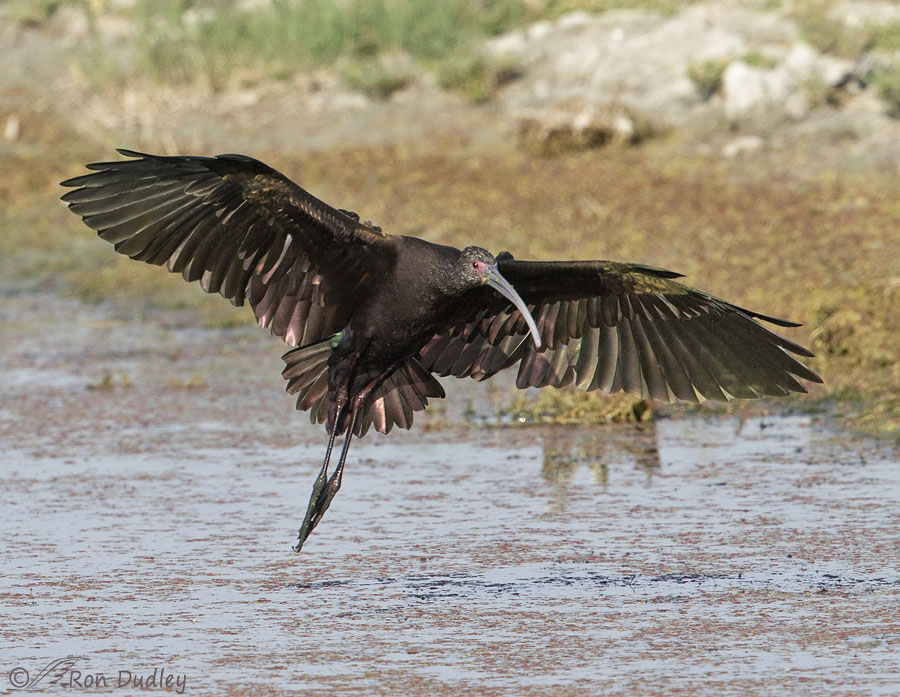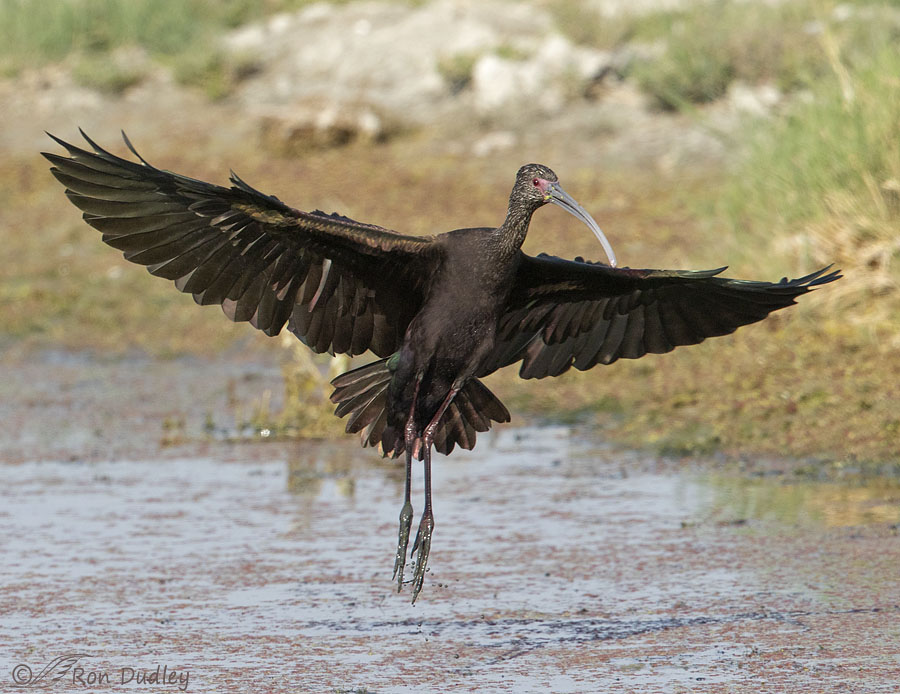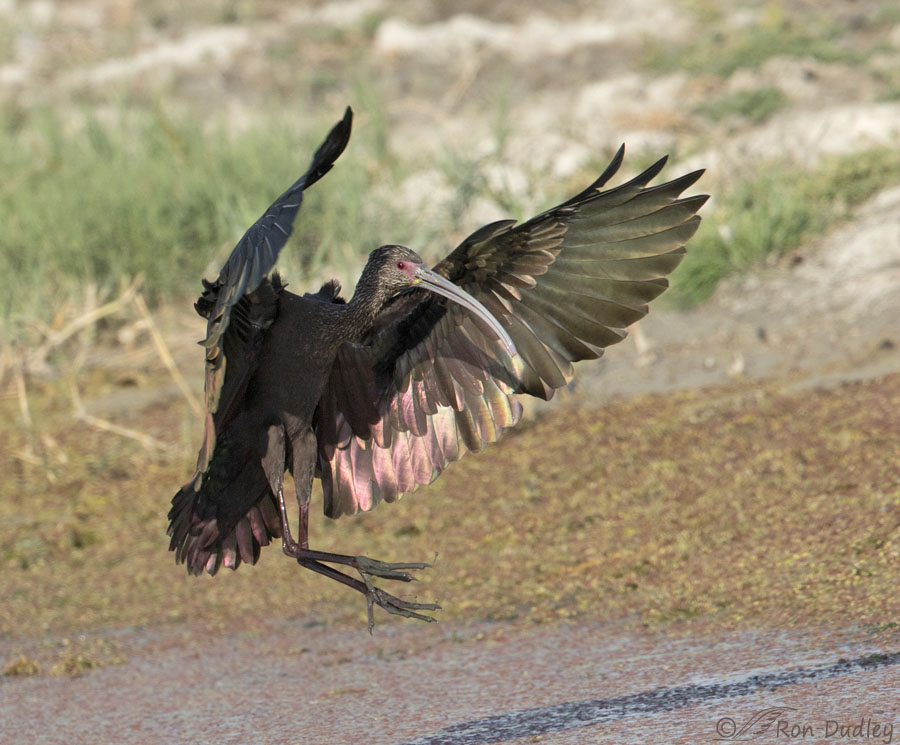A species I seldom post so I figured it’s about time.
Yesterday morning I visited Farmington Bay WMA for the second time since they opened the gate for the season. I usually don’t spend much time there until it gets colder but several days earlier my first visit had been productive so I decided to give it another go. Birds were slower yesterday but I did manage to get a few interesting shots.

1/2000, f/7.1, ISO 500, Canon 7D Mark II, Canon EF 500mm f/4L IS II USM + EF 1.4 III Extender, not baited, set up or called in
White-faced Ibis and Snowy Egrets were feeding together at the 4-way pond so I spent some time with them despite the messy water. This ibis had a good light angle on ‘him’ during his landing approach so I attempted to follow him with my lens, with mixed results. This is probably my favorite shot of the series because his flared posture caught enough of the sun to light up much of his metallic bronze plumage.
Even though at this point he’s very close to the water he’s still traveling at breakneck speed, much too fast to attempt a landing in the shallow water. Besides, his intended landing spot is still much further ahead.

1/2000, f/7.1, ISO 500, Canon 7D Mark II, Canon EF 500mm f/4L IS II USM + EF 1.4 III Extender, not baited, set up or called in
In the next photo in the burst he was really putting on the air brakes which quickly began to slow him down.
Then I lost focus on him for four frames.

1/2000, f/7.1, ISO 500, Canon 7D Mark II, Canon EF 500mm f/4L IS II USM + EF 1.4 III Extender, not baited, set up or called in
I reacquired focus when he was just about to stick the landing but after this shot I lost it again. That’s bird photography for you. I find it quite difficult to keep a bird in sharp focus and completely in frame when they’re flying at or near right angles to me, especially when the background’s this close to the bird..
Sometimes my success rate is better than this and sometimes it’s worse.
Ron


I didn’t realize they were iridescent.
I often saw black ibis fill the tree tops along Bayou Teche when I lived in Louisiana in the 1970s.
At that time, only 1 species was recognized but I kept telling my Cajun husband with a PhD in zoology that I thought there were 2 different kinds of the black ibis. He disagreed about that possibility as well as the one I had brought up previously about the differences from the Eastern Towhee picture in field guides and what I was seeing in Arizona.
Pam, sounds like you have a ‘lumpers and splitters’ marriage…
Maybe that’s part of why it didn’t last!
I see lots of beauty in this bird — especially when the feathers are all lit up! (Of course, I also think that condors and vultures are beautiful, so I may not be the best arbiter of “bird beauty.”
(Of course, I also think that condors and vultures are beautiful, so I may not be the best arbiter of “bird beauty.”  )
)
Marty, I could go with lots of superlatives for vultures but beautiful probably wouldn’t be one of them.. :).
WOW! Definitely a beautifully ungainly bird, but like others have mentioned, there’s beauty everywhere. You just have to SEE it! And yes, the abalone shells are a good comparison. And I also agree with Sallie Reynolds. Your photos take me there with all the sounds and the feel of the winds stirred up by those wings! What a delight!
Thanks very much, Laura.
Love the colours of the plumage, and am awed that it can stick a landing at speed.
Perhaps not the most ‘attractive’ of birds, but an amazing athlete.
It’s funny, EC. Some folks think they’re quite attractive but I’m in your camp.
Your photos make him look huge, but BotW says ” Medium-sized wading bird”. They don’t occur here in the Pacific NW, so I compared his size to the Great Blue Heron. About half the size. Looks can be deceiving. What beautiful coloration (despite the face).
Lyle, they’re a little larger than the Snowy Egrets they were foraging with.
Sensational series Ron! Thanks for sharing!
Charlotte Norton
Thanks, Charlotte.
This grand series gives me a deep, gut-level sense of what it feels like to fly – as the bird is fine-tuning his or her landing, I could feel it. Air rushing, feathers tickling, muscles aching. And that frisson of “will I make this?” Thanks.
Good. Thank you, Sallie.
Am captivated by the first photo Ron, love everything about it including the water. This series reminds me of the French phrase “jolie laide” which roughly means “pretty-ugly.” It’s a phrase used to explain the beauty in the unique. Wish we had an equivalent in English. There is beauty everywhere when we take the moment to notice. Thank you for giving us beauty everyday (usually along with an interesting lesson).
I appreciate the French lesson, Kathleen. Previously the only French I knew was a rather rude phrase…
All our lakes where these wading birds gather have that same “messy” water as the drought continues and the water continues to recede. Good photos. The Ibis take off and move to a new position frequently, but you have to be really ready to move with them and I rarely am. Their landing shots are more difficult than most people would think. I have a really neat photo showing their iridescence that I will send you.
Everett, as your photo illustrates their various colors really come out when the light hits them just right.
You need to go there more often. Gorgeous shots!
Jean, it’s almost the time of year when I definitely will be going more often.
What an unusual quality of iridescence–almost like abalone shell interior–
a nice grace note for a very strange-looking bird……bet those huge feet give
good traction in moving water ? Yours is the first glimpse I’ve ever had of this
species.
I like your comparison to abalone shell, Kris. As a kid living in SoCal I was fascinated by those shells. I remember that some folks used them as ash trays which I thought bordered on criminal.
Beautiful shots and beautiful plumage on an otherwise somewhat unattractive (to me) bird! The sun REALLY lights him up in the 3rd picture…..
The sun REALLY lights him up in the 3rd picture….. Glad you’re getting some bird action finally………
Glad you’re getting some bird action finally………
Judy, I’ve never found them particularly attractive either and for me their grunting pig-like call somehow reinforces that impression. For that reason it caught my eye last night when read Cornell’s description of them – “an attractive, long-legged wader”.
But beauty is in the eye of the beholder and when the light hits them just right their colors can knock your socks off.
Beautiful shots!
Thanks, Dick.